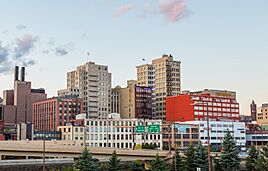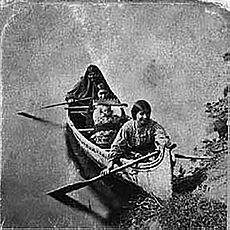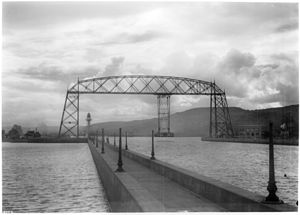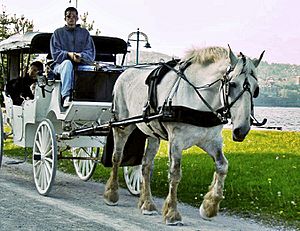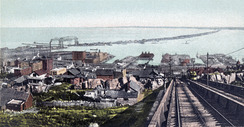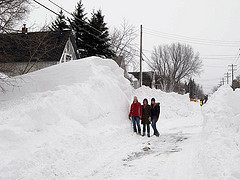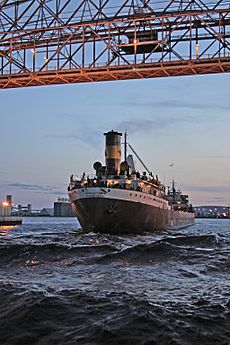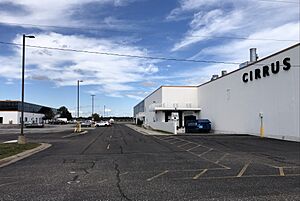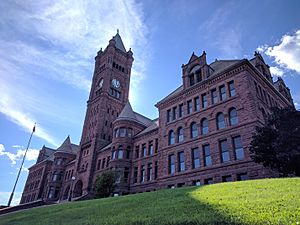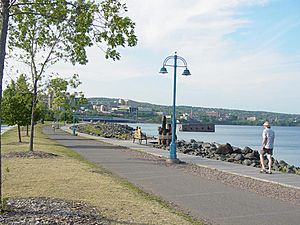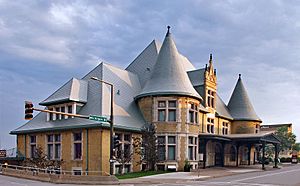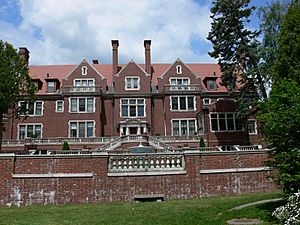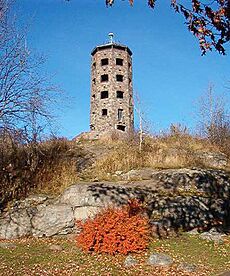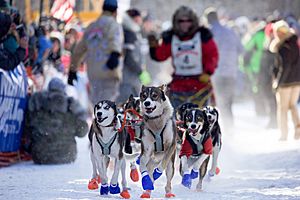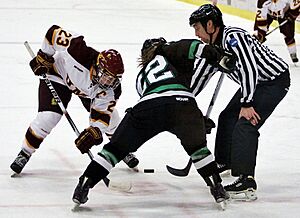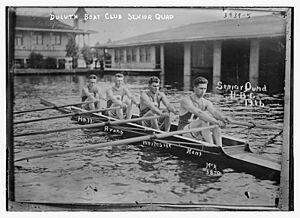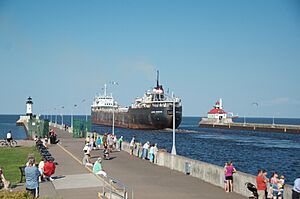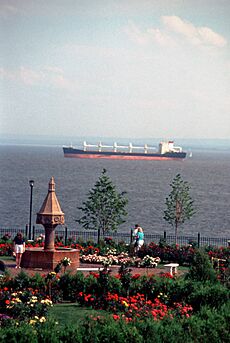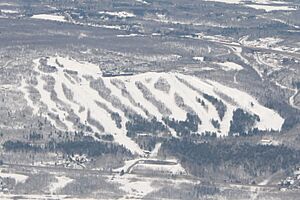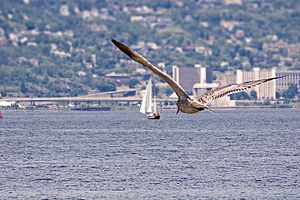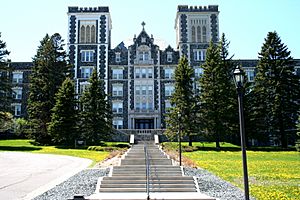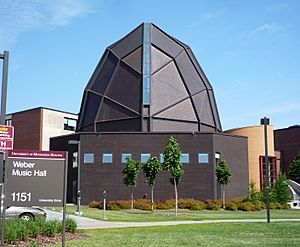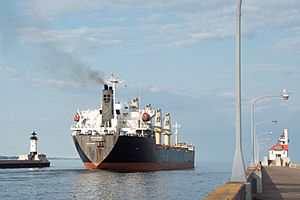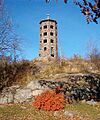Duluth, Minnesota facts for kids
Quick facts for kids
Duluth, Minnesota
|
|||
|---|---|---|---|
|
|
|||
|
|||
| Nickname(s):
Zenith city of unsalted seas
|
|||

Location of Duluth in St. Louis County, Minnesota
|
|||
| Country | United States | ||
| State | Minnesota | ||
| County | St. Louis County | ||
| Metro | Twin Ports | ||
| First Settled | 1850-51 | ||
| Platted | 1856 | ||
| Incorporated (town) | May 19, 1857 | ||
| Incorporated (city) | March 5, 1870 | ||
| Incorporated (city charter) | March 2, 1887 | ||
| Named for | Daniel Greysolon, Sieur du Lhut | ||
| Government | |||
| • Type | Mayor–council | ||
| • Body | Duluth City Council | ||
| Area | |||
| • City | 80.168 sq mi (207.634 km2) | ||
| • Land | 71.658 sq mi (185.593 km2) | ||
| • Water | 8.510 sq mi (22.041 km2) 22.46% | ||
| • Urban | 66.87 sq mi (173.20 km2) | ||
| • Metro | 8,413.17 sq mi (21,790.01 km2) | ||
| Elevation | 705 ft (215 m) | ||
| Population
(2020)
|
|||
| • City | 86,697 | ||
| • Estimate
(2023)
|
87,680 | ||
| • Rank | US: 398th MN: 4th |
||
| • Density | 1,223.51/sq mi (472.39/km2) | ||
| • Urban | 119,411 (US: 281st) | ||
| • Urban density | 1,785.8/sq mi (689.5/km2) | ||
| • Metro | 281,603 (US: 177th) | ||
| • Metro density | 33.46/sq mi (12.92/km2) | ||
| • Combined | 326,968 (US: 112nd) | ||
| • Combined density | 29.50/sq mi (11.39/km2) | ||
| Demonym(s) | Duluthian | ||
| GDP | |||
| • Metro | .822 billion (2022) | ||
| Time zone | UTC−6 (Central (CST)) | ||
| • Summer (DST) | UTC−5 (CDT) | ||
| ZIP Codes |
55801–55808, 55810–55812, 55814–55816
|
||
| Area code(s) | 218 | ||
| FIPS code | 27-17000 | ||
| GNIS feature ID | 661145 | ||
| Sales tax | 8.875% | ||
Duluth (![]() i/dəˈluːθ/ DƏ-looth) is a busy port city in Minnesota, a state in the United States. It is the main city of St. Louis County. Duluth is located on Lake Superior in Minnesota's Arrowhead Region. It is a major center for shipping goods by boat. In 2020, about 86,697 people lived there, making it Minnesota's fifth-largest city.
i/dəˈluːθ/ DƏ-looth) is a busy port city in Minnesota, a state in the United States. It is the main city of St. Louis County. Duluth is located on Lake Superior in Minnesota's Arrowhead Region. It is a major center for shipping goods by boat. In 2020, about 86,697 people lived there, making it Minnesota's fifth-largest city.
Duluth and its neighbor, Superior, Wisconsin, are often called the Twin Ports. Duluth is south of the Iron Range and the Boundary Waters Canoe Area Wilderness. The city is named after Daniel Greysolon, Sieur du Lhut, who was the first known European explorer in the area.
Duluth sits on the north shore of Lake Superior, at the very western end of the Great Lakes. It is the biggest city in the U.S. on Lake Superior. Ships can travel from Duluth all the way to the Atlantic Ocean, which is about 2,300 miles (3,700 km) away. They use the Great Lakes Waterway and St. Lawrence Seaway to do this. The Port of Duluth is the world's farthest inland port that large ocean ships can reach. It is also the biggest and busiest port on the Great Lakes. Many items are shipped from Duluth, including coal, iron ore, grain, and wind turbine parts.
Duluth is a popular place for tourists in the Midwest. You can visit the Great Lakes Aquarium, which has many freshwater animals. The Aerial Lift Bridge, near Canal Park, goes over the Duluth Ship Canal. This canal leads into the Duluth–Superior harbor. Minnesota Point, also called Park Point, is the longest freshwater sandbar in the world, stretching about 6 miles (10 km). Duluth is also a great starting point for trips along the North Shore of Lake Superior. You can drive all the way to Thunder Bay, Ontario, in Canada.
Contents
- History of Duluth
- Geography of Duluth
- People and Population
- Duluth's Economy
- Arts and Culture in Duluth
- Sports in Duluth
- Parks and Recreation
- Education in Duluth
- Media in Duluth
- City Infrastructure
- Notable People from Duluth
- Duluth Innovations
- Sister Cities
- See also
- Images for kids
History of Duluth
Early Native American Life
The Ojibwe people lived in a historic settlement called Onigamiinsing. This name means "at the little portage." It was a place where people carried their canoes between Lake Superior and the St. Louis Bay. Both the Ojibwe and the Dakota people traded furs with Europeans when they first met.
Ojibwe stories say that Spirit Island, near the Spirit Valley area, was the "Sixth Stopping Place." Here, the northern and southern groups of the Ojibwe Nation met. Then they moved to their "Seventh Stopping Place," near the city of La Pointe, Wisconsin. These "Stopping Places" were areas where Native Americans lived as they moved west. They were moving because Europeans were taking over their lands.
European Explorers and Fur Trade
Fur traders came to the Great Lakes in the early 1600s. This was because beaver hats were popular in Europe, creating a high demand for animal furs. The French had used up most of the beavers near the St. Lawrence River by the 1630s. So, they looked further west for new furs and new trade routes. They made friends with Native American tribes to help them trap and deliver furs.
Étienne Brûlé is thought to be the first European to discover Lake Superior before 1620. Pierre-Esprit Radisson and Médard des Groseilliers explored the Duluth area, called Fond du Lac (Bottom of the Lake), in 1654 and again in 1660. The French soon set up fur trading posts near Duluth. One major trading center was in the far north at Grand Portage. The French explorer Daniel Greysolon, Sieur du Lhut, explored the St. Louis River in 1679. The city of Duluth is named after him.
After 1792, when the United States became independent, the North West Company set up trading posts. These posts were on Minnesota rivers and lakes. They traded with the Ojibwe, Dakota, and other tribes. The first post was where Superior, Wisconsin, is now. It was called Fort St. Louis and became a main office for the North West Company. It had strong walls, houses, a warehouse, and a canoe area. Over time, Native Americans and Europeans settled nearby, and a town grew there.
In 1808, John Jacob Astor started the American Fur Company. This company began trading at the Head of the Lakes in 1809. In 1817, they built a new main office at today's Fond du Lac on the St. Louis River. From here, people could carry goods between Lake Superior, Lake Vermilion, and the Mississippi River. Astor left the fur business around 1830 as it started to slow down. But fur trading continued until the 1840s. European styles changed, and many areas in America had too much trapping, so animal numbers went down.
In 1832, Henry Schoolcraft visited the Fond du Lac area. He wrote about his experiences with the Ojibwe Indians there. Henry Wadsworth Longfellow used Schoolcraft's writings to create his famous poem, "The Song of Hiawatha." This poem tells the story of an Ojibwe warrior named Hiawatha.
Native Americans signed two Treaties of Fond du Lac with the United States. These were in 1826 and 1847 in the Fond du Lac area. In these treaties, the Ojibwe gave land to the American government. As part of the Treaty of Washington (1854), the United States set aside the Fond du Lac Indian Reservation. This reservation is upstream from Duluth near Cloquet, Minnesota.
Duluth's Permanent Settlement
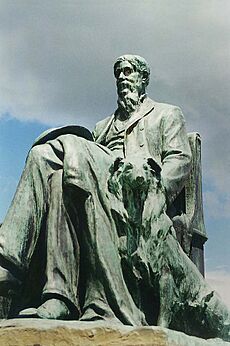
As more Europeans settled in Ojibwe lands, the U.S. government made treaties. These treaties, from 1837 to 1889, took large areas of tribal lands. They moved Native American people to smaller reservations. In the 1850s, people became interested in the area because of rumors of copper mining. A land survey in 1852 and a treaty in 1854 opened up the wilderness. This led to a land run and the start of iron ore mining. The 1854 Ojibwe Land Cession Treaty moved the Ojibwe to the Fond du Lac and Grand Portage Reservations. However, they kept some rights, like hunting and fishing.
Around the same time, new channels and locks in the East allowed large ships to reach the area. A road was also built connecting Duluth to the Twin Cities. Eleven small towns formed on both sides of the St. Louis River. This is how Duluth began as a city.
By 1857, copper was hard to find. The area's economy then focused on cutting timber. A financial crisis in 1857, called the Panic of 1857, made most early settlers leave. A Duluth history book from 1910 said, "Of the handful remaining in 1859 four men were unemployed and one of those was a brewer. Capital idea; build a brewery." They got water from a stream that flowed into Lake Superior, now called Brewery Creek. The brewery was not very successful at first, but later became the famous Fitger Brewing Company.
The opening of the canal at Sault Ste. Marie in 1855, along with new railroads, made Duluth special. It became the only port with access to both the Atlantic and Pacific oceans. Soon, the lumber industry, railroads, and mining grew very fast. Many workers came, and new shops appeared quickly. By 1868, Duluth was thriving. Dr. Thomas Preston Foster, who started Duluth's first newspaper, called it "The Zenith City of the Unsalted Seas."
In 1869–70, Duluth was the fastest-growing city in the country. People thought it would soon be bigger than Chicago. Jay Cooke, a rich land investor, helped the Lake Superior and Mississippi Railroad extend its line from St. Paul to Duluth. This railroad opened up areas north and west of Lake Superior for iron ore mining. On New Year's Day 1869, Duluth had only 14 families. By the Fourth of July, 3,500 people were there to celebrate.
In 1873, Cooke's business failed, and the stock market crashed. Duluth almost disappeared. But by the late 1870s, with lumber and mining booming again and railroads finished, Duluth grew strong once more. By 1900, it had almost 100,000 people. It was a busy community with loans for small businesses and lots of trade. Mining continued in the Mesabi Range, and iron was sent east to factories in Ohio. This trade lasted into the 1900s.
Why was Duluth called "The Zenith City"?
Early on, some people doubted Duluth's future. A U.S. Representative named J. Proctor Knott from Kentucky gave a funny speech in 1871. He joked about Duluth, calling it a paradise in flowery words. This speech, "The Untold Delights of Duluth," is now famous for its humor. The nearby city of Proctor, Minnesota, is named after Knott.
Duluth, Georgia, got its name in 1871, after Knott's speech became well-known. A Georgia newspaper owner, Evan P. Howell, joked that his town should be called "Duluth." The townspeople liked the idea.
Some people think Proctor Knott called Duluth the "zenith city of the unsalted seas." But it was actually journalist Thomas Preston Foster who first used this phrase in 1868.
Duluth in the 20th Century
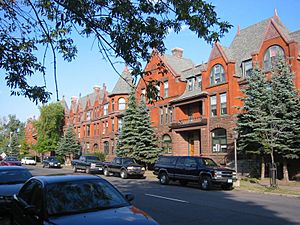
For a time in the 20th century, the Port of Duluth was the busiest port in the United States. It even handled more cargo than New York City. Large Lake freighters carried iron ore through the Great Lakes. This ore went to processing plants in Illinois and Ohio. Duluth had ten newspapers, six banks, and an 11-story skyscraper called the Torrey Building. By 1905, Duluth was said to have the most millionaires per person in the U.S.
In 1907, U.S. Steel announced it would build a $5 million factory in the area. Steel production started in 1915. People thought Duluth's population would grow to 200,000–300,000. Along with the Duluth Works steel plant, US Steel built Morgan Park. This was a company town for steel workers. It is now a neighborhood in Duluth.
The Diamond Calk Horseshoe Company started in 1908. It later became a big maker of wrenches and car tools. Marshall Wells Hardware Company, a huge wholesale business, opened branches in Portland, Oregon, and Winnipeg, Manitoba, in 1901. Their catalog had 2,390 pages by 1913. The Duluth Showcase Company, which later became the Coolerator Company, was founded in 1908. The Universal Atlas Cement Company, which made cement from steel plant waste, began in 1917.
Immigration to Duluth
Many jobs in mining and industry made Duluth a popular place for immigrants from Europe in the early 1900s. It became a major center for Finnish communities outside Finland. For many years, a Finnish newspaper called Päivälehti was printed in the city. Immigrants from Sweden, Norway, Denmark, Germany, Ireland, Italy, Poland, and other countries also settled in Duluth. Today, many people in Duluth have Scandinavian family roots.
The 1918 Cloquet Fire
In 1918, the Cloquet Fire swept through Carlton and southern St. Louis counties. It destroyed many communities near Duluth. This fire was the worst natural disaster in Minnesota's history for lives lost in one day. The National Guard from Duluth tried to fight the fire and help victims. But the fire was too big for them to stop.
Duluth's Continued Growth
For the first half of the 20th century, Duluth was a busy industrial port city. It had many grain elevators, a cement plant, and steel mills. Handling and shipping iron ore from the Mesabi Range was very important to Duluth's economy. It also helped the steel industry in the Midwest.
The Aerial Lift Bridge was built in 1905. At first, it was a rare aerial transfer bridge. This type of bridge uses a moving platform to carry people and cars. In 1929–30, it was changed into a vertical-lift bridge. The bridge was added to the National Register of Historic Places in 1973.
In 1916, during World War I, a shipyard was built on the St. Louis River. A new neighborhood for workers, now called Riverside, grew around it. Similar industrial growth happened during World War II. Duluth's large harbor and natural resources helped the war effort. Tankers and submarine chasers were built at the Riverside shipyard. Duluth's population kept growing after the war, reaching its highest point of 107,884 people in 1960.
Economic Changes in Duluth
Duluth's economy started to slow down in the 1950s. This happened when the high-quality iron ore ran out in the Iron Range north of Duluth. Shipping ore from Duluth's harbor was very important to the city's economy. Low-quality ore, called taconite, was still shipped. New technology for taconite pellets helped, but overall ore shipments were lower.
In the 1970s, the United States faced a steel crisis. Like many American cities, Duluth's industries changed. In 1981, US Steel closed its Duluth Works plant. This hurt the city's economy a lot. The cement company also closed because it needed raw materials from the steel plant. Other industries, like shipbuilding, also closed. By the end of the 1980s, 15 percent of people were out of work. This was especially hard on Duluth's West Side, where many immigrant families had lived for decades.
During the 1980s, plans were made to extend Interstate 35 through Duluth. The first plan would have built the highway along the shore, blocking views of Lake Superior. A local architect, Kent Worley, asked the mayor to rethink the route. The Minnesota Department of Transportation agreed. The new plan put parts of the highway in tunnels. This saved important places like Fitger's Brewery and Leif Erikson Park. Rocks from the highway project were used to create a new beach along Lake Superior. The city's Lakewalk was built along this beach.
Duluth in the 21st Century
As industries declined, Duluth's economy slowly changed to focus on tourism. The downtown area was updated to be more friendly for walking. Streets were paved with red brick, and new shops and hotels were added. Old warehouses along the waterfront became cafes, shops, and restaurants. These changes, along with the new beach and Lakewalk, created the popular Canal Park for tourists. Duluth's population, which had gone down since 1960, became steady at around 85,000 people.
Today, Duluth is a regional center for banking, shopping, and medical care. It serves northern Minnesota, Wisconsin, and Michigan. More than 8,000 jobs in Duluth are directly linked to its two hospitals. Art, entertainment, outdoor activities, and nature have also helped the tourism industry grow. About 3.5 million visitors come each year, bringing over $400 million to the local economy.
Recently, a group of business owners started to rebuild and improve Lincoln Park. This was an older neighborhood with high unemployment. Since 2014, many businesses have opened there. These include restaurants, breweries, coffee shops, and art studios. Because of this growth, many builders are also investing in new housing projects.
Waterfront Renewal Efforts
Duluth's importance as a port city helped it grow early on. But as industries slowed, new efforts began to open up the waterfront for public use. One big effort is restoring the St. Louis River area. Many sites there had pollution from old industries. The EPA has been cleaning them up. New projects, like the Pier B Resort and Hotel, show how these old industrial areas can be made new again.
The Duluth Waterfront Collective is also working to reclaim waterfront space. One idea is to change the I-35 highway that runs through downtown. The city council voted in 2021 to look into options for this area.
While less land is used for port activities now, the types of goods shipped have changed. There are fewer shipments of coal and iron ore. But there are more shipments of wind turbine parts and large shipping containers.
Geography of Duluth
Duluth covers about 87.43 square miles (226.44 km2). About 67.79 square miles (175.58 km2) is land, and 19.64 square miles (50.87 km2) is water. It is Minnesota's second-largest city by land area. Duluth's canal connects Lake Superior to the Duluth–Superior harbor and the Saint Louis River. The Aerial Lift Bridge crosses this canal. It connects Canal Park with Minnesota Point (or "Park Point"). Minnesota Point is about 7 miles (11 km) long. When combined with Wisconsin Point, it is the largest freshwater baymouth bar in the world, about 10 miles (16 km) long.
Duluth's land is mostly a steep hillside that rises from Lake Superior. Because of this, Duluth has been called "the San Francisco of the Midwest." This is because San Francisco also has hills and water. Before World War II, Duluth had streetcars and an inclined railroad. This railroad, like San Francisco's cable cars, climbed a steep hill. The difference in height is big. The airport by the lake is 607 feet (185 m) high. But Duluth International Airport, on top of the hill, is 820 feet (250 m) higher, at 1,427 feet (435 m).
Even as Duluth grew, most people stayed near Lake Superior. So, Duluth is mainly a city that stretches from southwest to northeast. The many buildings on the hill mean Duluth has many steep streets. Some neighborhoods, like Piedmont Heights, are on top of the hill. They have great views of the city. Skyline Parkway is a scenic road that runs almost the entire length of Duluth. It offers views of Lake Superior, the Aerial Lift Bridge, and Canal Park.
A growing part of the city is the Miller Hill Mall area. This area has many large stores "over the hill" along the Miller Trunk Highway. Road work in 2009–10 improved traffic flow in this area. A new international airport terminal was finished in 2013.
Duluth's Geological History

Duluth's geology shows the Midcontinent Rift. This formed when North America began to split apart about 1.1 billion years ago. As the Earth's crust got thinner, hot rock called magma rose up. This formed a 16 km (10 mi) thick rock layer, mostly of gabbro, called the Duluth Complex.
The Lake Superior basin was shaped by huge glaciers. These ice sheets moved over Minnesota many times in the last 2 million years. The mile-thick ice easily wore away the sandstone in the valley. But it had more trouble with the harder igneous rocks on the sides of the valley, which are now the edges of the lake. When the last glacier melted, the lake filled up. It was as high as 500 feet (150 m) above its current level. The Skyline Parkway roughly follows one of the highest levels of this ancient lake, called Glacial Lake Duluth. The sandstone that covered the igneous rocks is visible near Fond du Lac. This stone, called Fond du Lac or Lake Superior brownstone, was used in many buildings in Duluth and other cities. The weathered sandstone forms the sandy bottom and shores of Park Point.
Duluth's Climate
| Weather chart for Duluth | |||||||||||||||||||||||||||||||||||||||||||||||
|---|---|---|---|---|---|---|---|---|---|---|---|---|---|---|---|---|---|---|---|---|---|---|---|---|---|---|---|---|---|---|---|---|---|---|---|---|---|---|---|---|---|---|---|---|---|---|---|
| J | F | M | A | M | J | J | A | S | O | N | D | ||||||||||||||||||||||||||||||||||||
|
24
-7
-16
|
26
-4
-14
|
37
2
-8
|
64
10
-1
|
86
17
5
|
112
22
10
|
100
25
13
|
95
24
13
|
88
20
9
|
74
12
2
|
50
3
-5
|
37
-4
-12
|
||||||||||||||||||||||||||||||||||||
| temperatures in °C precipitation totals in mm |
|||||||||||||||||||||||||||||||||||||||||||||||
|
Imperial conversion
|
|||||||||||||||||||||||||||||||||||||||||||||||
Duluth has a humid continental climate (Köppen Dfb). Lake Superior makes the weather a little milder. Winters are long, snowy, and very cold. Temperatures stay at or below 32°F (0°C) for about 100 days. They drop to or below 0°F (-18°C) on about 38 nights. Snow usually covers the ground from late November to early April. Winter storms can bring heavy lake-effect snow, sometimes a foot (30 cm) or more. Areas further inland get much less snow. The average yearly snowfall is 90.2 inches (229 cm).
Duluth is one of the coldest cities in the United States. This is based on its average lowest monthly temperatures.
Summers are warm, but nights are generally cool. Daytime temperatures average 78°F (26°C) in July. Temperatures reach or go above 90°F (32°C) only about two days a year. The city has only officially reached 100°F (38°C) three times, all in July 1936. You often hear "cooler by the lake" in summer weather forecasts. This is especially true when an easterly wind is expected. Weather can change quickly in Duluth due to the big difference in height between the hilltop and the shore. Sometimes, it snows in higher areas while it rains near Lake Superior.
The coldest temperature ever recorded in Duluth was -41°F (-41°C) on January 2, 1885. The hottest was 106°F (41°C) on July 13, 1936. On average, the first freezing temperature is on September 30, and the last is on May 14. Snow usually falls between October 22 and April 26.
| Climate data for Duluth Int'l, Minnesota (1991–2020 normals, extremes 1871–present ) | |||||||||||||
|---|---|---|---|---|---|---|---|---|---|---|---|---|---|
| Month | Jan | Feb | Mar | Apr | May | Jun | Jul | Aug | Sep | Oct | Nov | Dec | Year |
| Record high °F (°C) | 55 (13) |
58 (14) |
81 (27) |
88 (31) |
95 (35) |
97 (36) |
106 (41) |
97 (36) |
95 (35) |
86 (30) |
75 (24) |
56 (13) |
106 (41) |
| Mean maximum °F (°C) | 39 (4) |
43 (6) |
56 (13) |
71 (22) |
82 (28) |
86 (30) |
89 (32) |
87 (31) |
82 (28) |
74 (23) |
55 (13) |
40 (4) |
90 (32) |
| Mean daily maximum °F (°C) | 19.9 (−6.7) |
24.8 (−4.0) |
36.2 (2.3) |
49.2 (9.6) |
63.0 (17.2) |
72.1 (22.3) |
77.7 (25.4) |
75.8 (24.3) |
67.2 (19.6) |
52.7 (11.5) |
37.1 (2.8) |
24.7 (−4.1) |
50.0 (10.0) |
| Daily mean °F (°C) | 11.2 (−11.6) |
15.4 (−9.2) |
27.0 (−2.8) |
39.5 (4.2) |
52.0 (11.1) |
61.2 (16.2) |
67.0 (19.4) |
65.5 (18.6) |
57.2 (14.0) |
44.1 (6.7) |
29.8 (−1.2) |
17.1 (−8.3) |
40.6 (4.8) |
| Mean daily minimum °F (°C) | 2.4 (−16.4) |
6.0 (−14.4) |
17.8 (−7.9) |
29.9 (−1.2) |
41.0 (5.0) |
50.2 (10.1) |
56.2 (13.4) |
55.2 (12.9) |
47.3 (8.5) |
35.6 (2.0) |
22.5 (−5.3) |
9.6 (−12.4) |
31.1 (−0.5) |
| Mean minimum °F (°C) | −22 (−30) |
−17 (−27) |
−7 (−22) |
15 (−9) |
29 (−2) |
38 (3) |
46 (8) |
45 (7) |
33 (1) |
22 (−6) |
3 (−16) |
−14 (−26) |
−24 (−31) |
| Record low °F (°C) | −41 (−41) |
−39 (−39) |
−29 (−34) |
−5 (−21) |
16 (−9) |
27 (−3) |
35 (2) |
32 (0) |
23 (−5) |
6 (−14) |
−29 (−34) |
−35 (−37) |
−41 (−41) |
| Average precipitation inches (mm) | 0.95 (24) |
1.01 (26) |
1.46 (37) |
2.53 (64) |
3.37 (86) |
4.39 (112) |
3.92 (100) |
3.73 (95) |
3.48 (88) |
2.91 (74) |
1.96 (50) |
1.47 (37) |
31.18 (792) |
| Average snowfall inches (cm) | 16.8 (43) |
15.1 (38) |
12.8 (33) |
9.1 (23) |
0.8 (2.0) |
0.0 (0.0) |
0.0 (0.0) |
0.0 (0.0) |
0.1 (0.25) |
2.7 (6.9) |
14.1 (36) |
18.7 (47) |
90.2 (229) |
| Average precipitation days (≥ 0.01 in) | 10.4 | 8.9 | 9.6 | 11.3 | 12.7 | 12.4 | 11.9 | 10.8 | 11.6 | 11.9 | 11.0 | 10.7 | 133.2 |
| Average snowy days (≥ 0.1 in) | 13.1 | 10.9 | 8.0 | 5.7 | 0.6 | 0.0 | 0.0 | 0.0 | 0.1 | 2.1 | 9.0 | 12.9 | 62.4 |
| Average relative humidity (%) | 72.0 | 69.8 | 69.3 | 63.6 | 62.7 | 69.5 | 70.9 | 74.5 | 75.7 | 71.4 | 74.9 | 76.3 | 70.9 |
| Average dew point °F (°C) | 0.3 (−17.6) |
4.5 (−15.3) |
15.4 (−9.2) |
25.5 (−3.6) |
36.5 (2.5) |
48.2 (9.0) |
55.0 (12.8) |
54.0 (12.2) |
45.7 (7.6) |
34.0 (1.1) |
21.2 (−6.0) |
7.2 (−13.8) |
29.0 (−1.7) |
| Mean monthly sunshine hours | 132.7 | 149.7 | 190.7 | 229.5 | 263.5 | 272.8 | 307.5 | 261.8 | 194.0 | 150.4 | 98.5 | 102.3 | 2,353.4 |
| Percent possible sunshine | 47 | 52 | 52 | 56 | 57 | 58 | 64 | 60 | 51 | 44 | 35 | 38 | 53 |
| Source: NOAA (relative humidity, dew point, and sun 1961–1990) | |||||||||||||
| Climate data for Superior, Wisconsin (adjacent to Duluth, 1991–2020 normals, extremes 1909–present) | |||||||||||||
|---|---|---|---|---|---|---|---|---|---|---|---|---|---|
| Month | Jan | Feb | Mar | Apr | May | Jun | Jul | Aug | Sep | Oct | Nov | Dec | Year |
| Record high °F (°C) | 55 (13) |
60 (16) |
80 (27) |
92 (33) |
96 (36) |
98 (37) |
105 (41) |
99 (37) |
97 (36) |
89 (32) |
79 (26) |
60 (16) |
105 (41) |
| Mean maximum °F (°C) | 41.3 (5.2) |
45.0 (7.2) |
56.7 (13.7) |
70.4 (21.3) |
82.3 (27.9) |
87.3 (30.7) |
91.1 (32.8) |
89.4 (31.9) |
83.3 (28.5) |
74.7 (23.7) |
57.1 (13.9) |
43.0 (6.1) |
92.7 (33.7) |
| Mean daily maximum °F (°C) | 22.5 (−5.3) |
26.9 (−2.8) |
36.1 (2.3) |
46.0 (7.8) |
57.4 (14.1) |
67.0 (19.4) |
76.1 (24.5) |
74.8 (23.8) |
66.6 (19.2) |
53.0 (11.7) |
39.1 (3.9) |
27.3 (−2.6) |
49.4 (9.7) |
| Daily mean °F (°C) | 14.1 (−9.9) |
18.0 (−7.8) |
28.5 (−1.9) |
38.9 (3.8) |
49.1 (9.5) |
58.2 (14.6) |
67.1 (19.5) |
66.4 (19.1) |
58.4 (14.7) |
45.8 (7.7) |
32.4 (0.2) |
20.2 (−6.6) |
41.4 (5.2) |
| Mean daily minimum °F (°C) | 5.8 (−14.6) |
9.1 (−12.7) |
21.0 (−6.1) |
31.8 (−0.1) |
40.9 (4.9) |
49.5 (9.7) |
58.0 (14.4) |
58.0 (14.4) |
50.1 (10.1) |
38.6 (3.7) |
25.6 (−3.6) |
13.1 (−10.5) |
33.5 (0.8) |
| Mean minimum °F (°C) | −17.2 (−27.3) |
−10.9 (−23.8) |
−1.4 (−18.6) |
18.3 (−7.6) |
30.6 (−0.8) |
39.2 (4.0) |
47.1 (8.4) |
47.0 (8.3) |
35.3 (1.8) |
25.1 (−3.8) |
7.9 (−13.4) |
−9.3 (−22.9) |
−19.5 (−28.6) |
| Record low °F (°C) | −37 (−38) |
−38 (−39) |
−38 (−39) |
−2 (−19) |
11 (−12) |
25 (−4) |
34 (1) |
31 (−1) |
19 (−7) |
9 (−13) |
−19 (−28) |
−32 (−36) |
−38 (−39) |
| Average precipitation inches (mm) | 0.81 (21) |
0.89 (23) |
1.41 (36) |
2.64 (67) |
3.37 (86) |
4.56 (116) |
3.88 (99) |
3.92 (100) |
3.39 (86) |
3.17 (81) |
2.12 (54) |
1.29 (33) |
31.45 (799) |
| Average snowfall inches (cm) | 14.5 (37) |
12.4 (31) |
9.1 (23) |
1.7 (4.3) |
0.0 (0.0) |
0.0 (0.0) |
0.0 (0.0) |
0.0 (0.0) |
0.0 (0.0) |
0.2 (0.51) |
5.8 (15) |
12.3 (31) |
56.0 (142) |
| Average precipitation days (≥ 0.01 in) | 7.1 | 5.6 | 7.1 | 8.8 | 11.6 | 11.5 | 10.4 | 9.6 | 9.9 | 9.7 | 8.1 | 7.0 | 106.4 |
| Average snowy days (≥ 0.1 in) | 6.8 | 5.2 | 3.7 | 1.6 | 0.0 | 0.0 | 0.0 | 0.0 | 0.0 | 0.1 | 3.1 | 5.7 | 26.2 |
| Source: NOAA | |||||||||||||
Duluth's 2012 Flood
From June 19–20, 2012, Duluth had its worst flood ever. About 9 inches (230 mm) of rain fell in 30 hours. Because of its rocky ground and many streams, the city could not handle all the water. The mayor declared a state of emergency and asked for national help. The governor of Minnesota sent the National Guard and the Red Cross to help. Many sinkholes opened up, causing a lot of damage. Streets turned into fast-moving rivers, and some roads broke apart. Part of West Skyline Parkway slid down the hill, cutting off a neighborhood. The Saint Louis River also flooded, isolating the Fond du Lac neighborhood.
Duluth's 2012 Tornado
Tornadoes are rare in Duluth because of its location near Lake Superior. However, on August 9, 2012, a tornado touched down on Minnesota Point. It started as a waterspout in Superior Bay. It quickly moved onto the sandbar's shore, making it a true tornado. It caused no serious damage. The tornado was rated as an EF0, which is the weakest type. The National Weather Service first said it was Duluth's first tornado. But later, they found records of a "miniature tornado" on May 26, 1958. It damaged a garage and two cabins. Another possible tornado was reported on July 11, 1935, in the Gary-New Duluth area.
People and Population
| Historical population | |||
|---|---|---|---|
| Census | Pop. | %± | |
| 1860 | 80 | — | |
| 1870 | 3,131 | 3,813.8% | |
| 1880 | 3,483 | 11.2% | |
| 1890 | 33,115 | 850.8% | |
| 1900 | 52,969 | 60.0% | |
| 1910 | 78,466 | 48.1% | |
| 1920 | 98,917 | 26.1% | |
| 1930 | 101,453 | 2.6% | |
| 1940 | 101,065 | −0.4% | |
| 1950 | 104,511 | 3.4% | |
| 1960 | 107,312 | 2.7% | |
| 1970 | 100,578 | −6.3% | |
| 1980 | 92,811 | −7.7% | |
| 1990 | 85,493 | −7.9% | |
| 2000 | 86,918 | 1.7% | |
| 2010 | 86,265 | −0.8% | |
| 2020 | 86,697 | 0.5% | |
| 2023 (est.) | 87,680 | 1.6% | |
| U.S. Decennial Census 2020 Census |
|||
In 2023, there were about 38,843 households in Duluth. Each household had about 2.15 people. The average household income was $61,163. About 17.7% of the people in the city lived in poverty. Duluth had an employment rate of about 68.0%. About 44.4% of the people had a bachelor's degree or higher. Also, 95.8% had a high school diploma.
The 2023 American Community Survey estimated Duluth's population. About 85.09% were White. About 2.35% were African American. About 0.89% were Native American. About 2.39% were Asian. About 0.14% were Pacific Islander. About 1.55% were from other races. And 7.59% were from two or more races. Hispanic or Latino people made up about 2.76% of the population.
The average age in the city was 37.0 years old.
Duluth's Population by Race and Ethnicity
Historically, most people in Duluth were non-Hispanic whites. Since 1990, there has been a small but growing number of Black, Asian, and Hispanic people.
| Race / ethnicity (NH = non-Hispanic) | Pop. 1990 | Pop. 2000 | Pop. 2010 | Pop. 2020 | % 1990 | % 2000 | % 2010 | % 2020 |
|---|---|---|---|---|---|---|---|---|
| White alone (NH) | 81,674 | 80,043 | 77,184 | 72,984 | 95.53% | 92.09% | 89.47% | 84.18% |
| Black or African American alone (NH) | 730 | 1,389 | 1,955 | 3,001 | 0.85% | 1.60% | 2.27% | 3.46% |
| Native American or Alaska Native alone (NH) | 1,779 | 2,056 | 2,011 | 2,077 | 2.08% | 2.37% | 2.33% | 2.40% |
| Asian alone (NH) | 760 | 989 | 1,287 | 1,381 | 0.89% | 1.14% | 1.49% | 1.59% |
| Pacific Islander alone (NH) | — | 25 | 28 | 34 | — | 0.03% | 0.03% | 0.04% |
| Other race alone (NH) | 40 | 64 | 54 | 293 | 0.05% | 0.07% | 0.06% | 0.34% |
| Mixed race or multiracial (NH) | — | 1,431 | 2,441 | 4,869 | — | 1.65% | 2.83% | 5.62% |
| Hispanic or Latino (any race) | 510 | 921 | 1,305 | 2,058 | 0.60% | 1.06% | 1.51% | 2.37% |
| Total | 85,493 | 86,918 | 86,265 | 86,697 | 100.00% | 100.00% | 100.00% | 100.00% |
As of the 2020 census, Duluth's population was 86,697. The city had about 1,209 people per square mile (467/km2). There were 39,762 homes. The racial makeup of the city was 85.0% White, 3.6% Black or African American, 2.6% Native American, 1.6% Asian, 0.8% from other races, and 6.5% from two or more races. About 2.4% of the population was Hispanic or Latino.
The most common family backgrounds in Duluth were German (24.0%), Norwegian (14.2%), Swedish (10.3%), Irish (9.8%), and Polish (6.7%). Most residents (95.2%) were born in the United States, and 72.7% were born in Minnesota. Most people (95.2%) spoke only English at home, and 1.7% spoke Spanish. About 94.5% had at least a high school degree, and 39.0% had at least a Bachelor's degree.
Duluth's Economy
Duluth is a main center for health care, higher education, shopping, and business services. It serves not only its own area but also northeastern Minnesota, northwestern Wisconsin, and parts of Michigan. It is also a big transportation hub for shipping coal, taconite, farm products, and steel. Recently, there has been a lot of growth in shipping parts for wind turbines. These parts come from Europe and North Dakota. Large industrial machines from all over the world are also shipped through Duluth. They are often headed for oil projects in northern Alberta, Canada. The Port of Duluth handles about 35 million short tons of cargo and nearly 900 ship visits each year. It is one of the top 20 U.S. ports by weight of goods shipped.
Most of the ships (90%) that use the port are "Lakers." These are large cargo ships built just for the Great Lakes. They are too big to fit through the Welland Canal. The other ships are "Salties," which can travel all the way from the Atlantic Ocean.
The Twin Ports area has attracted new engineering companies. These include TKDA, Barr Engineering, and LHB. New businesses have also started, like Loll Designs and Epicurean, which make eco-friendly furniture and kitchen tools. Bent Paddle is a local microbrewery. The women's clothing store Maurices has its main office in Duluth. Luggage companies Duluth Pack and Frost River are also based here. In 1989, the workwear brand Duluth Trading Company started on a boat in Duluth's shipping area. The company moved its main office to Wisconsin in 2000. The supermarket chain Super One Foods is also based in the Twin Ports, with its main office in nearby Hermantown.
Duluth is a center for studying water life and science. The city has the EPA's Mid-Continent Ecology Division Laboratory. The University of Minnesota Duluth also has programs in this field. These places have led to many important businesses that help Duluth's economy. Some of these businesses include ERA Laboratories and LimnoLogic.
The city is popular for tourism. Duluth is a good starting point for trips to the beautiful North Shore using Highway 61. You can also visit fishing and wilderness spots in northern Minnesota. These include the Superior National Forest and the Boundary Waters Canoe Area Wilderness. Tourists can also drive the North Shore Scenic Drive to places like Gooseberry Falls State Park.
In 2006, a group of volunteers worked to manage the city's retirement health care costs. These costs were so high they threatened to bankrupt the city. The mayor called it "the single most important volunteer effort in our city's history." After changes and a court case, the problem was largely solved by 2014.
Top Employers in Duluth
Here are the 10 largest employers in Duluth, based on a 2023 report:
| # | Employer | Type of Business | # of Employees |
|---|---|---|---|
| 1 | Essentia Health (St. Mary's/Duluth Clinic) | Healthcare / hospital | 9,004 |
| 2 | St. Luke's Hospital | Healthcare / hospital | 3,573 |
| 3 | St. Louis County | Government | 2,161 |
| 4 | Allete (Minnesota Power) | Electric utility | 1,810 |
| 5 | Cirrus Aircraft | Aviation | 1,600 |
| 6 | Duluth Public Schools ISD No. 709 | Education | 1,026 |
| 7 | Duluth Air National Guard Base | Military | 1,019 |
| 8 | Pine Journal | Newspaper | 1,000 |
| 9 | University of Minnesota Duluth | Education | 985 |
| 10 | United Healthcare | Insurance | 900 |
Aviation in Duluth
Several international aviation companies operate near Duluth. Since 1994, Cirrus Aircraft has had its main office and factories in the city. As of 2023, nearly 1,600 people work there. They build the world's best-selling small plane, the SR22. They also make the world's first single-engine personal jet, the Vision SF50. The growth of Cirrus has been very important for Duluth's modern development. Cirrus is Duluth's largest manufacturer and third-largest employer. In 2012, AAR Corp opened an aircraft repair facility at the Duluth airport.
In January 2013, the Duluth International Airport opened a new terminal. It is named the U.S. Representative James L. Oberstar Terminal.
The Air National Guard's 148th Fighter Wing is at the Duluth Air National Guard Base. It is the city's sixth-largest employer. This unit can train Air Force pilots. The 179th Fighter Squadron is part of the 148th.
Minnesota's biggest airshow, the Duluth Air & Aviation Expo, happens every summer. It is held at Duluth International Airport.
Arts and Culture in Duluth
The Historic Old Central High School, built in 1892, now has a museum. It shows a classroom from the 1890s. The building has a 230-foot (70 m) clock tower. Its chimes are like those of Big Ben in London. The clock faces are 10.5 feet (3.2 m) wide and look out over Duluth harbor. The building is listed on the National Register of Historic Places. It is a great example of Romanesque style.
Other museums include the Duluth Children's Museum. It was founded in 1930 and is one of the oldest children's museums in the U.S. It has interactive exhibits and programs for kids and families. The museum also has a collection of over 25,000 objects. These show the lives of people who lived in the region, especially Native Americans and immigrants. Other museums are the Tweed Museum of Art at the University of Minnesota Duluth and the Karpeles Manuscript Library Museum.
The main community art center is the Duluth Art Institute. It has galleries, a fiber studio, and a darkroom in the Depot downtown. It also has studios in the Lincoln Park neighborhood. Many local art galleries are also downtown and in Canal Park. The Duluth Public Library has three locations. Duluth is also home to the Minnesota Ballet. Duluth and Superior, Wisconsin, share a symphony orchestra, the Duluth Superior Symphony Orchestra. In summer, free concerts are often held in Chester Park. The Bayfront Blues Festival takes place in early August.
Duluth has several local theater groups. The Duluth Playhouse is one of the oldest community theaters in the United States. It was founded in 1914. Its main offices and two theaters are in the historic Depot Building. The Playhouse puts on many shows. It also has a well-known education program.
The NorShor Theatre is a historic movie palace that has been restored. It is now a place for live performances. This century-old building is an important local landmark. After 19 months of work, the NorShor Theatre reopened in 2018. It has a 600-seat auditorium, a bar, and a lounge.
Since 2004, Duluth has celebrated Gay Pride with a parade on Labor Day weekend. Since 1998, the city has held the Homegrown Music Festival in early May. It features over 170 local music acts. The Junior Achievement High School ROCKS – Battle of the Bands showcases middle and high school bands. It takes place at the Duluth Entertainment Convention Center (DECC) in mid-April. Duluth also hosts the Northeastern Minnesota Book Awards.
Fun Attractions in Duluth
Canal Park is a popular area with fun activities, restaurants, and shops. It used to be a warehouse district. But after industries declined in the 1980s, it became a place for recreation. A 2.6-mile (4.2 km) walking path offers views of Park Point's sand dunes and beaches. The path goes under the Aerial Lift Bridge. This vertical lift bridge crosses the Duluth Ship Canal into Duluth's harbor. The wreck of the Thomas Wilson, an old ore boat, lies underwater less than 1 mile (1.6 km) outside the harbor canal.
The Duluth Lakewalk is a 7-mile (11 km) walking and biking path. It starts in Canal Park and follows the lakeshore. It goes through Leif Erikson Park and the Duluth Rose Garden. It ends at Bayfront Festival Park, where festivals and concerts are held.
Duluth is the starting point for the North Shore of Lake Superior scenic route. This route goes from Duluth to Thunder Bay and Nipigon in Canada. It was popular with tourists even in the 1800s. Many boats traveled along the North Shore from Duluth. Tourists would then canoe or take ferries up the North Shore. They stayed in hunting camps, hotels, and cabins.
Great Lakes Aquarium
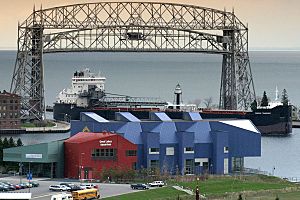
The Great Lakes Aquarium is in Duluth Waterfront Park. It is a freshwater aquarium. It has animals and habitats from the Great Lakes Basin and other freshwater places like the Amazon River. The aquarium has 205 different kinds of fish, birds, reptiles, amphibians, and mammals. It is one of the few aquariums in the U.S. that focuses on freshwater exhibits.
Lake Superior Maritime Museum
The Great Lakes Maritime Museum and Visitor Center has historical exhibits. It shows old maritime items and a recreated ship's pilot house. Children can pretend to steer the ship using a steering wheel. The exhibits include items from sunken ships in Duluth harbor. One exhibit tells the story of the SS Edmund Fitzgerald, which sank in a storm. There is also a small movie theater. Visitors can watch ships arriving in the harbor and find out when other ships will arrive.
William A. Irvin Ship Museum
The SS William A. Irvin was a ship that carried coal and iron on the Great Lakes for over 40 years. Now, it is docked in Duluth and is a museum. It shows what shipping was like on the Great Lakes. As the main ship of U.S. Steel's Great Lakes Fleet, it offered "comfort and elegance to important guests." It also carried materials from Two Harbors and Duluth to U.S. Steel's factories.
Lake Superior Railroad Museum
The Lake Superior Railroad Museum is in the Duluth Union Depot. It has many trains, including seven steam engines and 14 diesel engines. The collection includes the William Crooks, the first train to run in Minnesota. It also has the Duluth, Missabe and Iron Range Railway Number 227. This "Yellowstone" locomotive was one of the largest steam engines ever built. Only 18 Yellowstones were made, and Duluth has one of the three that are left.
North Shore Scenic Railroad
The North Shore Scenic Railroad is a historic railroad. It runs between Duluth and Two Harbors, Minnesota. The Lake Superior Railroad Museum owns it. It offers different types of passenger train rides from May to October each year. The railroad started in 1990. It uses the old Lakefront Line that belonged to the Duluth, Missabe and Iron Range Railway.
Fitger's Brewery Complex
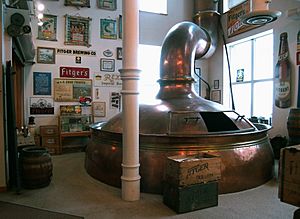
The first brewery was built in 1857 on a stream now called Brewery Creek. Michael Fink bought it in 1881 and moved it to its current spot on Superior Street. Fink's Lake Superior Brewery hired August Fitger, a skilled brewmaster. The brewery was renamed A. Fitger & Co. / Lake Superior Brewery. It became very successful and stayed open even during Prohibition. It finally closed in 1972 after 115 years, making it Duluth's oldest business. The complex reopened in 1984. It now has a craft brewery, restaurants, hotels, shops, and a museum. Fitger's Brewery Complex is listed on the National Register of Historic Places.
Glensheen Mansion
The Glensheen Historic Estate is on the shore of Lake Superior. It was the home of a wealthy businessman, Chester Adgate Congdon. Glensheen sits on 7.6 acres (3.1 ha) of lakefront land. It has 38 rooms and is built in the Jacobean style. Construction started in 1905 and finished in 1908. The mansion is open for tours all year.
Lake Superior Zoo
The 16-acre (6.5 ha) Lake Superior Zoo is open all year. It has animals from around the world. You can see Amur tigers, snow leopards, African lions, brown bears, and kangaroos. The zoo also has learning programs and special events.
Enger Tower
Enger Tower is an 80-foot (24 m), five-story stone tower on Enger Hill in Duluth. From the tower, you can see amazing views of the Twin Ports. There is a green light on top of the tower.
Hawk Ridge Bird Watching
Duluth is on the path of many bird flyways. Many migratory birds fly over the area. Hawk Ridge, on Skyline Parkway, is a great place to watch birds of prey. People from all over the world visit Hawk Ridge from Labor Day through October. Volunteers catch birds in nets and put bands on them. Large crowds watch this process.
Gichi-Ode' Akiing Park
Near the Lakewalk is a park called Gichi-Ode' Akiing. This Ojibwe name means "a grand heart place." The Duluth City Council approved this name change in 2018. A memorial to Kechewaishke, also known as Chief Buffalo, is in the park. It honors his request to President Millard Fillmore in 1849. Chief Buffalo signed the 1854 Treaty of La Pointe. He made sure that 1 square mile (2.6 km2) of land on Lake Superior was given to his adopted son, Benjamin G. Armstrong. This land, known as the Buffalo Tract, is part of downtown Duluth today.
Annual Events in Duluth
Duluth Airshow
The Duluth Airshow started in 2001. It is held every summer at the Duluth International Airport. It is Minnesota's largest airshow. Famous groups like the Blue Angels and US Air Force Thunderbirds have performed there.
John Beargrease Sled Dog Marathon
The John Beargrease Sled Dog Marathon is named after John Beargrease. He was a winter mail carrier. This annual sled dog race goes from Duluth to Grand Portage. Beargrease and his brothers carried mail by dogsled, boat, and horse for almost 20 years. This was before roads connected the towns. Competitors can choose between a 400-mile (640 km) round trip or a 150-mile (240 km) course. The race starts at Billy's Bar in northeastern Duluth. It has been run every January since 1980. It is seen as a practice race for Alaska's bigger Iditarod Trail Sled Dog Race.
Magic Smelt Parade
In May, people in Duluth celebrate the annual smelt run. They have the Magic Smelt Parade along the city's lakewalk. It is a family event like a New Orleans Second Line Parade. A brass band leads the "Main Line," and then "second liners" walk and dance behind them. The Smelt Parade's second liners wear silver hats, capes, and other smelt-related costumes. A Smelt King and Smelt Queens also join the parade.
Grandma's Marathon
Since 1977, Duluth has hosted Grandma's Marathon every June. It is named after its first sponsor, Grandma's Restaurant. Runners from all over the world come to this race. The course starts near Two Harbors, Minnesota. It runs along Old Highway 61 (the old route of Highway 61) along the North Shore of Lake Superior. It finishes in Canal Park. The same route is used for the North Shore Inline Marathon in September.
Christmas City of the North Parade
Every November, the Christmas City of the North Parade takes place in Duluth. The parade started in 1957. Bob Rich, who owned a TV station, wanted to make the Christmas shopping season longer. He came up with the idea. Since then, the parade has marched through downtown Duluth every year on the Friday before Thanksgiving. It has happened even in rain, snow, and cold weather. The "Christmas City" song, recorded by Merv Griffin in 1962, is the parade's special song.
Bentleyville Tour of Lights
Since 2009, the Bentleyville Tour of Lights has decorated the Bayfront Festival Park. It runs during November and December. It has over 5,000,000 lights. This free light display has been called the United States' "largest display of Christmas lights" that people can walk through.
Sports in Duluth
Duluth's Professional Sports History
Football Teams
| Duluth in the NFL | ||||
|---|---|---|---|---|
| Year | W | L | T | Finish |
| Kelleys | ||||
| 1923 | 4 | 3 | 0 | 7th |
| 1924 | 5 | 1 | 0 | 4th |
| 1925 | 0 | 3 | 0 | 16th |
| Eskimos | ||||
| 1926 | 6 | 5 | 3 | 8th |
| 1927 | 1 | 8 | 0 | 11th |
Duluth had a National Football League team called the Kelleys from 1923 to 1925. It also had the Eskimos from 1926 to 1927. The Eskimos were later sold and became the Orange Tornadoes. This history inspired the 2008 movie Leatherheads.
Baseball Teams
The Duluth–Superior Dukes played in West Duluth's Wade Stadium from 1993 to 2002. They were part of the Northern League Independent Professional Baseball. In 1997, the Dukes won the Northern League championship. An earlier Northern League also existed from 1902 to 1971. The Dukes were a farm team for the Detroit Tigers from 1960 to 1964. Many Dukes players later played for the 1968 world champion Detroit Tigers.
Boxing in Duluth
Duluth is home to Horton's Gym, where professional boxers like Zach "Jungle Boy" Walters and Andy Kolle trained. Chuck Horton ran the gym from 1994 to 2011. He trained many well-known boxers. In 2011, Walters took over the gym and renamed it Jungle Boy Boxing Gym.
Indoor Football
The Duluth-Superior Lumberjacks played in the IFL for two seasons (1999–2000). Their home games were at the DECC Arena.
In 2023, Duluth was announced as a team in The Arena League, an indoor football league starting in 2024. The DECC Arena will host the Duluth Harbor Monsters.
Amateur Sports in Duluth
Hockey Teams
The University of Minnesota Duluth Bulldog hockey games are shown on TV and watched by thousands in person at the DECC. A new hockey arena, Amsoil Arena, opened in 2010 next to the DECC. Several Bulldogs, like hockey star Brett Hull, have gone on to play in the National Hockey League. On April 9, 2011, the Bulldog men's team won their first national championship. They won again in 2018 and 2019.
The UMD women's ice hockey team has won five National Collegiate Athletic Association (NCAA) Division I national championships (2001–03, 2008, 2010). The 2010 championship game was the longest women's hockey championship game in NCAA history. The 2003 and 2008 women's Frozen Four tournaments were held at the DECC. The Women's Frozen Four was also held in Amsoil Arena in 2012.
Baseball Teams
The Duluth Dukes were an amateur baseball team. They played at Bulldog Park and Wade Stadium. The team had current and former college players and former professional players. The Dukes played in two leagues.
The Duluth Xpress is another amateur baseball team. They play at the Ordean Middle School baseball field. This team also has current and former college and professional players.
The Duluth Huskies are a college summer baseball team. They play in the Northwoods League at Wade Stadium. The team includes some of the best college baseball players in the country. They play 34 home games each summer.
The Twin Ports North Stars are an amateur baseball team. They play at Ordean Field at Duluth East High School. This team has current and former college and professional players from the Twin Ports area.
High school teams in Duluth include Denfeld High School, Duluth East High School, and Duluth Marshall School.
Rowing in Duluth
Rowing has a long history in Duluth. The Duluth Boat Club started in 1886. Between 1911 and 1923, Duluth won 20 national championships. Today, the club is still strong, and its members compete in races.
Soccer in Duluth
The National Premier Soccer League team Duluth FC plays its home games at Denfeld High School's Public Schools Stadium.
Bandy in Duluth
Bandy is a team sport similar to ice hockey. All American Bandy League games are played in Roseville, Minnesota. In 2012, the Duluth team Dynamo Duluth finished second in the league. In 2013, they won the championship for the first time.
Roller Derby in Duluth
Roller derby is a contact sport played on roller skates. The Harbor City Roller Derby, an 18+ league, started in 2007. It is Duluth–Superior's first women's flat-track roller derby league.
Curling in Duluth
The Duluth Curling Club was founded in 1891. It has met in the Duluth Entertainment Convention Center since 1976. The club had the team that won the gold medal in men's Olympic curling in 2018.
Parks and Recreation
Duluth has many parks. Six parks are on Lake Superior. These include Leif Erikson Park, which has a rose garden. Canal Park on Park Point and the Lakewalk are also popular. The Park Point Recreation Area has a community center, swimming beach, and picnic areas. Park Point Pine Forest is good for bird-watching. You can find a shipping schedule for ships entering the harbor. There are also live cameras of the canal and lift bridge.
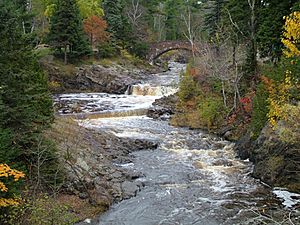
Other parks include historic Lester Park. A deep pool in Amity Creek attracts cliff diving. Amity Creek is also home to The Seven Bridges Road. This is a four-mile section of Skyline Parkway with many waterfalls.
Duluth's other parks include Congdon Park, Hartley Park, Chester Park, and Bayfront Festival Park. Many of these parks have trails and waterfalls. Hartley Park has a nature center. Lester Park and Enger Park have public golf courses. Fairmount Park has the Lake Superior Zoo. Jay Cooke State Park is a Minnesota state park about 10 miles (16 km) southwest of Duluth. It is one of Minnesota's most visited state parks.
Leif Erikson Park
For many years, the Leif Erikson ship was on display in Leif Erikson Park. This Viking ship was built in Norway to look like the ship Leif Erikson sailed to North America around 997 A.D. The ship is 42 feet (13 m) long. When the crew landed in Duluth in 1927, they had traveled 6,700 miles (10,800 km). This was the longest distance for a ship of its size in modern history.
Duluth resident Emil Olson bought the ship and gave it to the City of Duluth. It was put on display in Lake Park, which was later named Leif Erikson Park.
The Leif Erikson ship slowly fell apart due to neglect. In 1980, it was in such bad shape that people thought about burning it. This idea inspired Emil Olson's grandson, Will Borg, to gather volunteers and raise money to restore the ship. They raised $100,000. Restoration began in 1991. As of 2022, the ship is still being stored.
Inside Leif Erikson Park is the Duluth Rose Garden. It is a formal English garden with over 3,000 rose bushes. It also has 12,000 other plants. The garden is 6 acres (2.4 ha) big. It grows on soil over a highway tunnel. Brick walkways connect all the flower beds. There are many benches, an old horse fountain, and a marble gazebo. The garden is a popular place for summer weddings.
In August 1956, a bronze statue of Leif Erikson was added to the park. John Karl Daniels made the statue. The Norwegian American League and community members donated it.
Outdoor Recreation in Duluth
Duluth offers many outdoor activities. These include fishing, hiking, skiing, sailing, canoeing, kayaking, and mountain biking. Besides the two public golf courses, there are private golf clubs. Duluth has five public tennis courts and 63 private tennis club courts. The city has many ice rinks for skating and curling.
The University of Minnesota Duluth Recreational Sport Outdoor Program offers classes. You can learn to kayak, paddleboard, or canoe on whitewater rivers. They also have races in July. The program also teaches sea kayaking and rock climbing.
Superior Hiking and Piedmont Mountain Biking Trails
Duluth has a 39-mile (63 km) part of the Superior Hiking Trail. This trail is also part of the North Country National Scenic Trail, the longest hiking trail in the U.S. This part of the trail goes through Jay Cooke State Park and Spirit Mountain. It offers views of the Saint Louis River, the Twin Ports, and Lake Superior.
The hilly, 10-mile (16 km) Piedmont mountain biking trail crosses many bridges. It has scenic views of Duluth and the bay. This trail is good for both new and experienced riders.
Skiing in Duluth
Spirit Mountain is Minnesota's second-highest ski hill. It has a height difference of about 700 feet (210 m). The park has jumps from 15 feet (4.6 m) to over 60 feet (18 m). It also has many rails and boxes. Spirit Mountain opened an alpine coaster in 2010. In 2011, they planned to add a zip line, miniature golf, and snow tubing. Work began on downhill mountain bike trails in 2012.
Duluth also has a large Nordic skiing community. Many parks offer great places for Nordic skate skiing and classic cross-country skiing.
Chester Bowl is a city-owned park in Chester Park. It has a chairlift. Its daily lift ticket prices are very low. For many years, Chester Bowl was known for its ski jumps. These were removed in 2015 for safety reasons.
Sailing and Rowing in Duluth
Duluth has both a yacht and rowing club. Since 1969, the Trans Superior Race has been held every other year. It goes from Sault Ste. Marie, Ontario to Duluth. At almost 390 miles (630 km), it is said to be "the world's longest known freshwater sailboat race."
Duluth has hosted Tall Ships festivals since 2008. These events happen every three years. About 250,000 people gather to watch the old ships enter the harbor.
Surfing in Duluth
Surfing is a popular activity in Duluth on Lake Superior. This happens when conditions are right for big waves. UMD offers a course on learning to surf. Instructors say that when the wind blows from the Northeast, "Duluth becomes a legitimate surf town." They list Park Point, Lester River, and Stoney Point as good surfing spots.
Hunting for Agates
The Minnesota state gem, the Lake Superior agate, can be found on the shores of Lake Superior. You can also find them in streams, gravel pits, and road cuts. Duluth's Park Point is a great place to hunt for them. This is because winter ice and storms bring new rocks to the shores each year. Books are available in Duluth to help people learn about agates and how to find them.
Education in Duluth
Local colleges and universities include the University of Minnesota Duluth (UMD). The UMD campus has a medical school. The UMD Bulldogs won the Division I National Hockey Championship in 2011, 2018, and 2019. Other schools are The College of St. Scholastica, Lake Superior College, and Duluth Business University. The University of Wisconsin–Superior is in nearby Superior, Wisconsin.
Most public schools are managed by Duluth Public Schools. The schools have open enrollment. ISD 709 (Independent School District number 709) is rebuilding schools under a program called the "Red Plan." This plan aims to rebuild older schools and build four new ones. This will change where many students go to school.
Several independent and public charter schools also serve Duluth students. The largest is Duluth Edison Charter Schools, for grades K-8. Marshall School is a private college prep school for grades 4–12. Duluth's Catholic school system, Stella Maris Academy, has four campuses. There are also two Protestant schools, two Montessori schools, and six other charter and private schools.
Because it is near the Great Lakes, Duluth is home to the Large Lakes Observatory. This observatory operates the largest university-owned research vessel on the Great Lakes, the R/V Blue Heron. This ship is used for water research.
Media in Duluth
Local newspapers include the monthly BusinessNorth and the twice-weekly Duluth News Tribune. Free newspapers include the Transistor, The Zenith, and The Reader Weekly.
Magazines based in Duluth and distributed nationally include Lake Superior Magazine and New Moon Magazine.
Major television channels serving the area include KBJR-TV, KDLH, WDIO-DT, and KQDS-TV.
City Infrastructure
Public Transportation
The local bus system is run by the Duluth Transit Authority (DTA). It serves Duluth, Hermantown, Proctor, Rice Lake, and Superior, Wisconsin. The DTA uses buses made by Gillig and Proterra, including new hybrid and electric buses. Duluth also has Skyline Shuttle, which offers daily service to the Minneapolis-Saint Paul International Airport. Jefferson Lines provides daily service to the Twin Cities.
Railways
Duluth was connected to Minneapolis by the North Star passenger train from 1978 to 1985. The North Shore Scenic Railroad runs seasonal trips to Two Harbors. The former Duluth, Missabe and Iron Range Railway, now part of the Canadian National Railway, operates trains that carry taconite. Duluth is also served by the BNSF Railway, the Canadian Pacific Railway, and the Union Pacific Railroad.
There is a plan to bring back passenger train service between the Twin Cities and Duluth. This project is called the Northern Lights Express.
Air Transport
Duluth International Airport serves the city and nearby areas. It has daily flights to Minneapolis and Chicago. Other local airports are Duluth Sky Harbor on Minnesota Point and the Richard I. Bong Airport in Superior. Both are named after Major Richard Ira "Dick" Bong, a famous World War II pilot from nearby Poplar, Wisconsin.
Highways
Duluth is the northern end of Interstate Highway 35, which goes south to Laredo, Texas. U.S. Highways serving the area are U.S. Highway 53 and U.S. Highway 2. When entering Duluth on I-35, travelers can see most of the city from Thompson Hill. There are two freeway connections from Duluth to Superior. U.S. 2 connects via the Richard I. Bong Memorial Bridge. Interstate 535 runs with U.S. 53 over the John Blatnik Bridge.
Many state highways serve the area. Highway 23 connects Duluth to Sioux Falls, South Dakota. Highway 33 is a western bypass that connects Interstate 35 to U.S. 53. Highway 61 goes to Thunder Bay, Ontario, along the North Shore. Highway 61 and parts of Highways 2 and 53 are part of the Lake Superior Circle Tour.
Major Highways in Duluth
 Interstate 35
Interstate 35 Interstate 535
Interstate 535 U.S. Highway 2
U.S. Highway 2 U.S. Highway 53
U.S. Highway 53 Minnesota State Highway 23
Minnesota State Highway 23 Minnesota State Highway 61 – North Shore
Minnesota State Highway 61 – North Shore Minnesota State Highway 194 – Central Entrance – Mesaba Avenue
Minnesota State Highway 194 – Central Entrance – Mesaba Avenue Minnesota State Highway 210
Minnesota State Highway 210 Saint Louis County Road 4 – Rice Lake Road
Saint Louis County Road 4 – Rice Lake Road
Port of Duluth–Superior
The Duluth–Superior port is at the western end of the Saint Lawrence Seaway. It is North America's largest freshwater port that is farthest inland. The port handles about 46 million short tons (42 million tonnes) of cargo each year. It also sees over 1,100 visits from ships. With 49 miles (79 km) of waterfront, it is a top port for bulk cargo. Duluth is a major shipping port for taconite pellets. These are made from iron ore and sent to steel mills. You can find the arrival schedule of ships that pass under the bridge. Locals and visitors gather to watch them enter the harbor. Large parts of the Great Lakes freeze in winter, stopping most shipping from January to March.
Two types of ships regularly enter the port: lakers and salties. Lakers make up over 90% of the port traffic. They are large cargo ships built for the Great Lakes, some over 1,000 feet (300 m) long. They cannot fit through the St. Lawrence Seaway. Salties are smaller ships, up to 740 feet (230 m) long. They can travel the St. Lawrence Seaway. Lakers are usually black or rust colored, while salties are often blue, red, or green.
Utilities
Duluth gets its electricity from Duluth-based Minnesota Power. This company produces energy from plants in northern Minnesota and North Dakota. Minnesota Power mainly uses western coal to make electricity. But it also has small hydroelectric facilities. The largest is the Thomson Dam southwest of Duluth.
In 2006, Minnesota Power started buying energy from a new wind farm. In 2007, they made another agreement for more wind power. Construction began in 2010 on a new wind farm in North Dakota. This wind power will be sent to Minnesota using a 465-mile (748 km) direct current (DC) line.
Because of the demand for wind energy, Duluth has become a port for shipping wind energy parts. These parts come from overseas. Duluth is also a hub for shipping parts to wind energy sites in the Midwest.
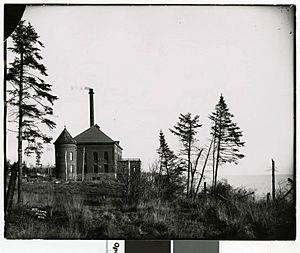
Duluth's water comes from Lake Superior. It is treated at the Lakewood Water Treatment Plant. The oldest building at the plant, the Lakewood Pumphouse, was built in 1896. It was designed to replace older facilities that could not stop a typhoid epidemic. A 42-inch (1.1 m) water pipe from 1896 is still used today. The system provides water to about 100,000 people in Duluth and nearby towns.
In the past, Duluth's sewers would overflow when it rained, sending untreated sewage into Lake Superior. For example, in 2001, over 6.9 million US gallons (26 million L) overflowed. Recently, the City of Duluth has worked hard to stop these overflows. By 2013, they were ahead of schedule on these improvements.
Fire Department
In 2013, the city of Duluth was protected by 132 paid firefighters. The Duluth Fire Department responded to 12,231 fire and emergency calls in 2015.
The Duluth Fire Department has eight fire stations. It uses six engines, one tower ladder, and other special vehicles.
Notable People from Duluth
Duluth Innovations
Here are some notable inventions and ideas that started in Duluth:
- Duluth pack: Patented in 1882, this backpack is used for canoe trips.
- Pie à la Mode: Invented in 1885, this is a slice of pie with a scoop of ice cream on top.
- Alexander Miles' electric elevator: Invented in 1887, this was a way to open and close elevator doors.
- Lark of Duluth: Launched in 1913, this was the first airline service in the United States. It carried people on joyrides over the Duluth–Superior harbor.
- Lake View Store: Opened in 1916, this was the first indoor shopping mall in the United States.
- Pizza snack rolls: Created by Duluth food maker Jeno Paulucci and trademarked in 1967.
- Aerostich Roadcrafter suit: Created in 1982, this was the first armored riding suit for motorcyclists made from synthetic fabric.
- Cirrus Airframe Parachute System: Developed in 1998, this was the first whole-plane parachute system for a line of aircraft.
Sister Cities
Duluth has five sister cities:
 Isumi, Chiba Prefecture, Japan
Isumi, Chiba Prefecture, Japan Petrozavodsk, Karelia, Russia
Petrozavodsk, Karelia, Russia Ranya, Kurdistan Region, Iraq
Ranya, Kurdistan Region, Iraq Thunder Bay, Ontario, Canada
Thunder Bay, Ontario, Canada Växjö, Kronoberg, Sweden
Växjö, Kronoberg, Sweden
See also
 In Spanish: Duluth (Minnesota) para niños
In Spanish: Duluth (Minnesota) para niños
Images for kids
-
Ojibwe women on the St. Louis River, long ago
-
Statue of Jay Cooke by Henry Shrady, located in Jay Cooke Plaza
-
Chester Terrace, built in 1890
-
Aerial Bridge around 1920, as a ferry bridge before it became a vertical-lift bridge
-
Minnesota Point (or Park Point) from Incline Railway, 1907
-
Anorthosite xenolith in Duluth, part of the Duluth Complex
-
Great Lakes Aquarium with lift bridge in background
-
Copper brew kettle installed in 1901, at the Fitger Brewery Museum
-
Al Franken and Wesley Ngetich Kimutai in the 2007 Grandma's Marathon
-
Lester River, one of 28 rivers and streams that run through Duluth
-
Duluth's Lakewood Pumphouse, built in 1896 and pictured in 1915, is still in use today


